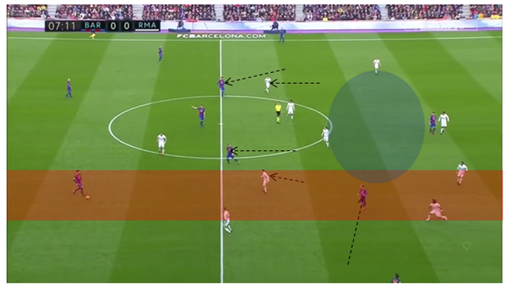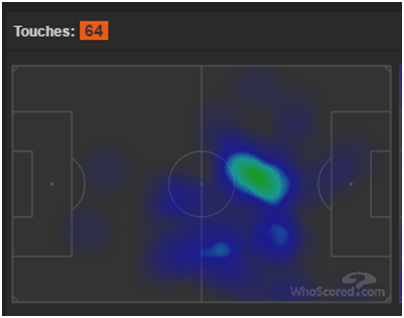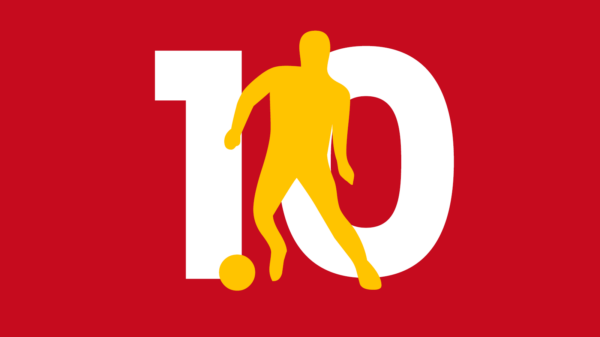Miles Olusina writes a detailed tactical analysis about the La Liga El Classico match that ended Barcelona 1-1 Real Madrid.
The 233rd edition of El Clásico saw Barcelona host Real Madrid in this mid-season encounter. For the home side, there was ground to make up as the visitors entered this fixture 6 points clear and seemingly unstoppable with a 32-game unbeaten streak before the match. A win for la Blaugrana was essential if they hoped to catch up to their eternal rivals, with Real taking maximum points from most of the league games played this season.
Both sides started the game with key players missing; for Barca, Andres Iniesta started on the bench while Madrid would have to do without Gareth Bale who sustained an ankle injury against Sporting Lisbon in their last Champions League fixture. The game was not the most memorable of Clásicos, as Real seemed intent on just maintaining their 6 point margin at the top as opposed to extending it, as was evidenced in their very defensive minded, transition focused approach. Barca were also wary of committing too many men forward in attacking phases, which resulted in quite a cagey affair as neither side were able to fashion too many clear cut chances. The home side dominated but found it difficult to control central areas due to Real’s superb defensive structure and spatial control. The game looked to be all but over with Barcelona 1-0 up in the 90th minute after Suarez’s 53rd minute header; however a Sergio Ramos equalizer in the dying minutes saw Real grab a vital point at the Camp Nou.
BARCELONA 1-1 REAL MADRID
Line Ups:

Made using TacticalPad.
Barcelona (4-3-3): 1. Ter Stegen // 20. Sergi Roberto, 3. Pique, 14. Mascherano, 18. Alba // 5. Busquets, 4. Rakitic, 21. Gomes // 10. Messi, 9. Suarez, 11. Neymar
Real Madrid (4-2-3-1): 1. Navas // 2. Carvajal, 5. Varane, 4. Ramos, 12. Marcelo // 19. Modric, 16. Kovacic // 17. Vasquez, 22. Isco, 7.Ronaldo // 9. Benzema
Substitutions: 60’ Iniesta (Rakitic), 78’ Turan (Gomes), 87’ Denis Suarez (Neymar) // 66’ Casemiro (Isco), 77’ Asensio (Benzema), 86’ Diaz (Kovacic)
Real’s central overloads and situational man-marking
For large periods of the game, the home side dominated the ball as you would expect from any Barcelona team. However, the vast majority of this possession was somewhat ineffective as they struggled to create any noteworthy chances for most of the match. That is not to say that Barca were poor on the day; it was more of a testament to Real Madrid’s excellent defensive display, which was made all the more impressive considering they were without their main provider of balance in the midfield in Casemiro.
A well co-ordinated and structured defensive scheme was key to their top class defensive showing in this game as they stopped Barcelona from gaining numerical superiorities in the centre and half-spaces. Their compact shape, especially in the 2nd defensive phase was key to this as the widest players in the block would often go no further than the half-space so as to maintain access to a Barca wide player who could potentially receive the ball on the wing while still allowing his team to retain horizontal compactness.

Real central overload in 2nd defensive phase
In this image above, we can see Real’s spatial control and how Barca have been forced to adapt as a result of Madrid’s compact shape. Both Vasquez and Isco are occupying the right half-space, meaning Real now have an overload in this zone. The whole positional structure of the home side has been jeopardized as they have no choice but to play round the block instead of between the lines as they would like. Suarez is looking to compensate for this by dropping deep but is being loosely cover shadowed by Modric.
The willingness of the forward players Ronaldo and Benzema to drop deep and support in the defensive phase is paramount to Real maintaining compactness and defensive overload as the 8s Modric and Kovacic do not need to vacate their position as often to apply pressure due to the presence of the forwards when defending. Instead they can focus on protecting the 6 space, which has the knock on effect of added protection for the back 4. Isco played a pivotal role also in Real’s defensive phase, functioning in almost a dual role in the defensive phase. In the Barca build- up phase he would take up a rather advanced position, loosely man-marking Sergio Busquets and helping his side to create a staggered shape in the build up to stay compact. Meanwhile, when his side were defending deeper in their own half, he would drop onto the same line as the two 8s to form a flat midfield 3 and create a 3v2 overload for his side against Rakitic and Andre Gomes.

Real’s situational man marking in 1st phase
Madrid did very well during the game to inhibit Barcelona’s ability to circulate the ball in central areas, predominantly through situational man-marking in the opposition build-up phase. In this particular scenario, Pique has possession and is looking to play into midfield, ideally through Rakitic or Busquets. However, Rakitic is being tracked by Kovacic in the half-space and Busquets is in the cover shadow of Benzema. On the other side, we can see Gomes dropping deep in case Pique plays a horizontal pass to Mascherano and Barca switch play to the other wing. He is also being pursued by Vazquez who has tucked in from the right wing and is maintaining access to Gomes. In the end, the ball is lost as Pique is unable to find a vertical option and play breaks down.
This could have been combatted through Rakitic’s movement though, as he could have moved more central which would have resulted in two different outcomes: 1. He would have more time in possession and could form a better support angle to combine with Messi in the right half-space; 2. Kovacic could have followed him all the way into the centre, resulting in the opening of a passing lane for Messi who could then play a one-two with Sergi Roberto.
Messi roaming and Iniesta introduction improve Barca ball circulation
Despite taking the lead through Suarez in the second half, the performance was not at the level expected from the Catalans as they struggled to maintain possession in midfield, failing to gain central presence and exploit the space that would occasionally appear between the lines. Barca boss Luis Enrique was quick to pick up on this, replacing Ivan Rakitic for Andres Iniesta in the 60th minute. This looked to be the perfect solution as in the 8 role also was Arda Turan, another excellent needle player with good close control who could help Barca retain the ball in the congested midfield area and draw players in to create space for others.
It is clear to see the instant impact made by the introduction of Iniesta whose presence immediately resulted in better ball retention for Barca due to intelligent movement off the ball and his ability to resist pressure with close control and positional intelligence.

This, combined with Messi’s increased dynamism and freedom in terms of movement led to a much more stable Barcelona side in possession as they were able to create numerical equalities when in the midfield. Messi’s movements especially were problematic for the marking scheme and defensive organization of Real Madrid as they were reluctant to follow him too often as it would result in spaces being left within their defensive block.
As the second half wore on, we began to see Messi occupy central areas more often and take advantage of the occasional man-orientations of the two Real Madrid 8s. As we can see above he has moved into the centre, attracting the attentions of Kovacic, who has now followed him which has resulted in space between the lines which Luis Suarez could have exploited up front had he chosen to drop into the 10 space.

Messi heatmap via WhoScored.com
Judging by his heatmap, he very rarely occupied the wing, instead favouring the centre due to the increased passing lanes and enhanced field of view, as well as greater variety in terms of tactical possibilities. He was able to create temporary overloads when in the centre and had more space when receiving the ball as could be found between the lines.
The advanced positioning of Ronaldo played a small part in this as Sergi Roberto could push further forward and occupy Marcelo at left-back while Messi roamed into central areas. To compensate for this, Isco would or Kovacic would occupy a position in the half-space to gain access to the wing if the ball was played there, however the advantage was still very much in Barcelona’s favour in the wing zone as Real were still looking to maintain their overload in the centre.
Conclusion
A very vital result for Real, who maintain their 6 point lead over their title rivals as a result of Ramos’ late equalizer. It is no less than they deserved, considering how well they performed defensively however they left a lot to be desired from an attacking sense, possibly due to the absence of key man Gareth Bale. Even still, they had more than enough talent in the side to cause more damage to Barca. With such a defensive approach, it was to be expected that Madrid would be more conservative in their attacking approach, favouring a more transition-based attacking style; but that was also lacking with them ceding possession rather easily and not preparing adequate structures for potentially dangerous attacks. From my perspective, they could do with a ball carrier in midfield, something they have lacked since the departure of Di Maria in 2014. That said, they are still in a very healthy position at this mid-season stage and with the next few games after the Club World Cup looking quite winnable, they could hold onto top spot for a while.
A rather sub-par league performance by Barcelona’s high standards; a far cry from the side that has dominated Spain and Europe over the past couple of seasons. While this was by no means a bad showing from the Catalans in this game, more was expected from them as they seemed to lack organization in the attacking phase, appearing to be reliant on the front three to produce a moment of brilliance as they so often do.
Read all our Tactical Analyses here.
- Scout Report: Marcus Thuram | Gladbach’s attacking sensation - July 17, 2020
- Tactical Philosophy: Paulo Fonseca - May 28, 2020
- Maurizio Sarri at Chelsea: Tactical Approach & Key Players - September 5, 2018


























































